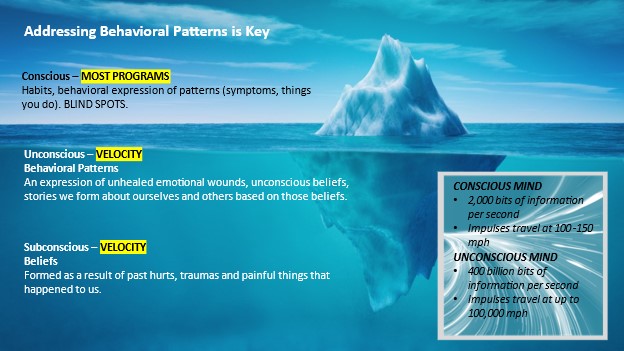Everyone has behavioral patterns that stifle performance. These patterns, referred to as “blind spots,” are often unrecognized consciously by the individual. Patterns in which executive leaders get stuck become ruts that prevent them from achieving the elite level of performance required to make a lasting impact in their organization. Because the behavior and its impact are indiscernible, the individual executive is unable to reach their full potential and help their company accelerate toward its goals.
How do leaders overcome these internal obstacles that hold them back from truly outstanding performance? The first step is understanding where behavioral patterns originate.
What is a behavioral pattern?
A behavioral pattern is a recurrent action by an individual or group toward a given object or situation. Some of the most common ruts in which we see leaders stuck include:
- Too little delegating
- Insufficient development of team members
- Hesitance to engage in healthy debate with the team
- Inadequate management of performance gaps with team members
- Low-level or absence of strategic or horizontal thinking and work
- Lack of or poor use of systems
- Avoidance of confrontation
- Reluctance to seek or give helpful, clear, feedback for improvement
- Cultural differences
- Concept that “my way” is the best or only way
Where do behavioral patterns originate?
To save energy, protect us, and achieve our highest good at the time, the mind establishes repetitive behavioral patterns. This is true for everyone and impacts every aspect of our lives. These patterns are formed in the unconscious mind, which processes 400 billion bits of information at a speed of up to 100,000 mph, compared to the conscious mind which processes only about 2,000 bits of information per second at only 100 – 150 mph. Therefore, behavior patterns easily become permanent – often digging into ruts – (see the inset box), at least until a person becomes aware of them and decides to change.
For business leaders, ruts can mean applying the same ineffective methods repeatedly, with the same lackluster results, affecting worker relationships, team development, strategy fulfillment, and more. Attempts to change habits through discipline or willpower leave leaders with the same blind spots and unrecognized patterns because they are working only at the conscious, surface level.

How does one change ineffective behavioral patterns?
Velocity’s science-based methodology focuses on the behavioral patterns that impede performance, replacing them with patterns that produce elite performance. Quantum leaps are possible only when work is done at the unconscious and subconscious levels, by focusing and aligning beliefs and behavioral patterns to support and multiply results.
Any behavioral pattern can be changed using these steps:
- Become aware of the pattern.
Pinpoint the pattern, be aware of when you run it, and note the corresponding results.
Identify the desired results and the new pattern that will create them. - Interrupt the behavior when you run it.
Once you have recognized the pattern, interrupt it every time you run it. - Run the new behavioral pattern instead.
Use the identified new pattern from Step 1 and run it when the old pattern is interrupted. Visualize what the attainment of your goal will look and feel like and how you CAN achieve it.
How long does it take to change behavioral patterns?
The key to change is running an interrupt and new behavior pattern every time. As in other areas of business, what gets measured gets achieved. That is why tracking these interrupt cycles helps executives change faster. Through years of helping executives change their behavior quickly, Velocity developed a proprietary app to help further accelerate the results – yielding dramatic change in the first 30 to 60 days. Unlike traditional coaching methods which use a “try and see” approach, our Power Pathways™ coaching methodology produces fast results. And participants do not revert to previous patterns – the process has built a new neural pathway in the brain and the behavioral pattern change is permanent. Change achieved in the executive suite can then ripple throughout the rest of the team and the entire organization.
To learn more, visit our website.
